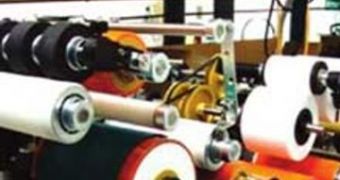Installing components just tens of nanometers thick onto their respective substrates in industrial quantities would clearly advance electronics production methods considerably. However, until now, this goal has remained elusive, in part because the necessary technology had not yet been developed. Now, scientists have finally managed to set in place the last details of a new printing technique that allows for nanostructures to be imprinted directly onto their substrates in significant amounts.
The process, called nanoimprint lithography, relies on mechanical forces to etch intricate nanoscale models onto various materials, setting the basis for a boom in nanotechnology-related fields of research. The method could be used to produce the required components for next-generation computer chips, as well as flexible solar cells, which could become cheaper and more efficient than existing ones. The features that can be imprinted with this type of lithography are also much smaller than the ones that can be made using the standard optical lithography, which is currently reaching its limits.
For quite some time now, several companies, including Austin, Texas-based Molecular Imprints, have worked on scaling up nanoimprint lithography to a level where it could handle “writing” more than a few inches of material at a time. “Displays and solar cells require printing over a much larger area and then cutting it up into sheets. You have to do it in a continuous fashion,” University of Michigan (UM) Associate Professor of Electrical Engineering and Computer Science Jay Guo explains, quoted by Technology Review.
In his work, Guo developed a method to bypass this obstacle, by employing polymer mold wrapped around a rolling cylinder, in a roll-to-roll system that could easily print larger surfaces with the same intricate, nanoscale patterns. The models that are just imprinted are then settled on their respective substrates through a photo-treatment, when flashes of ultraviolet light conclude the printing process. Details of the method can be found in the latest issue of the scientific journal ACS Nano.
At a rate of one meter per minute, the new technology has a “resolution” of 50 nanometers, which makes it too large to be of any use in creating integrated circuits. The microprocessor technology is already moving to the 32-nanometer standard. Instead, the prints obtained can be used for computer displays and for creating the next generation of solar cells.

 14 DAY TRIAL //
14 DAY TRIAL //